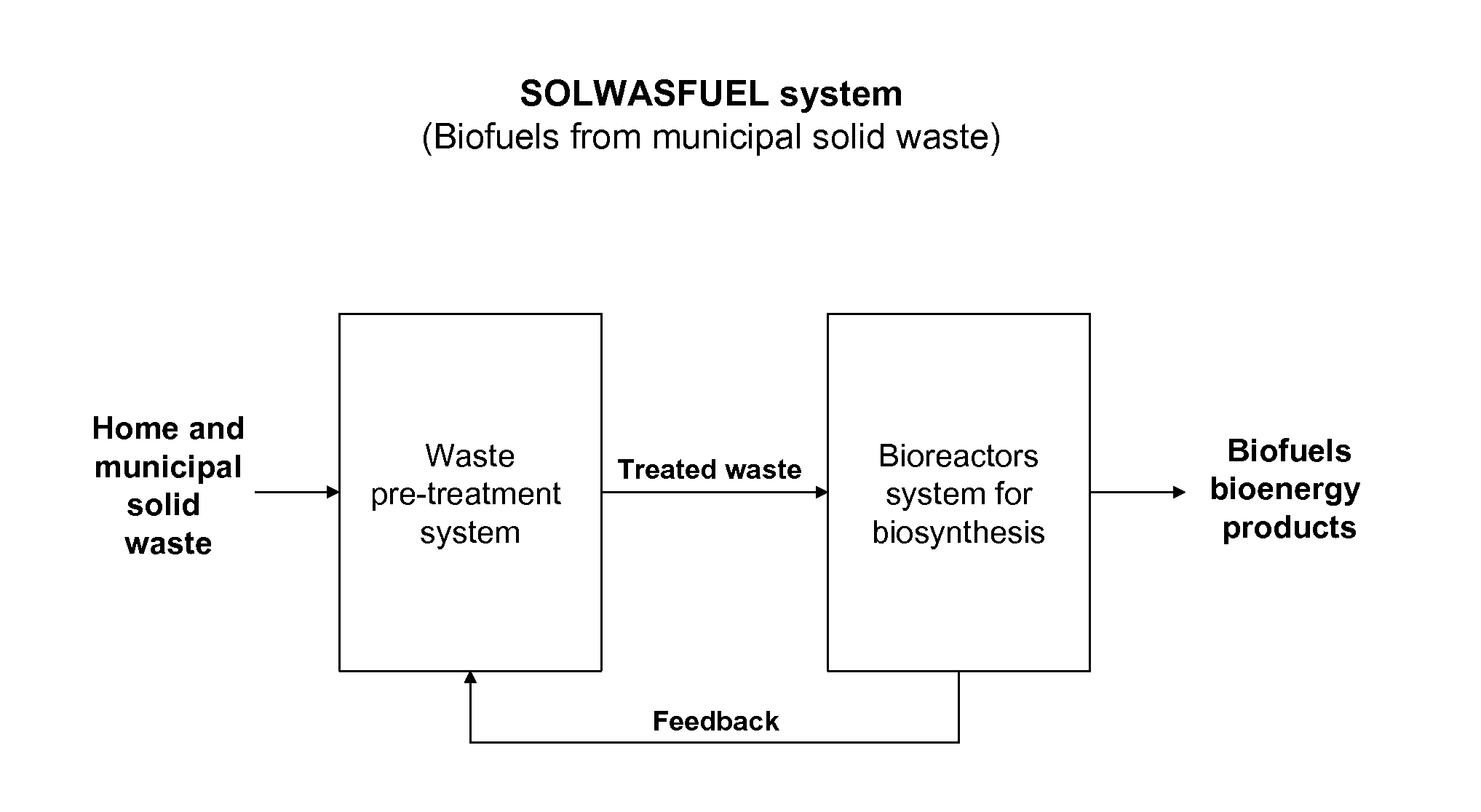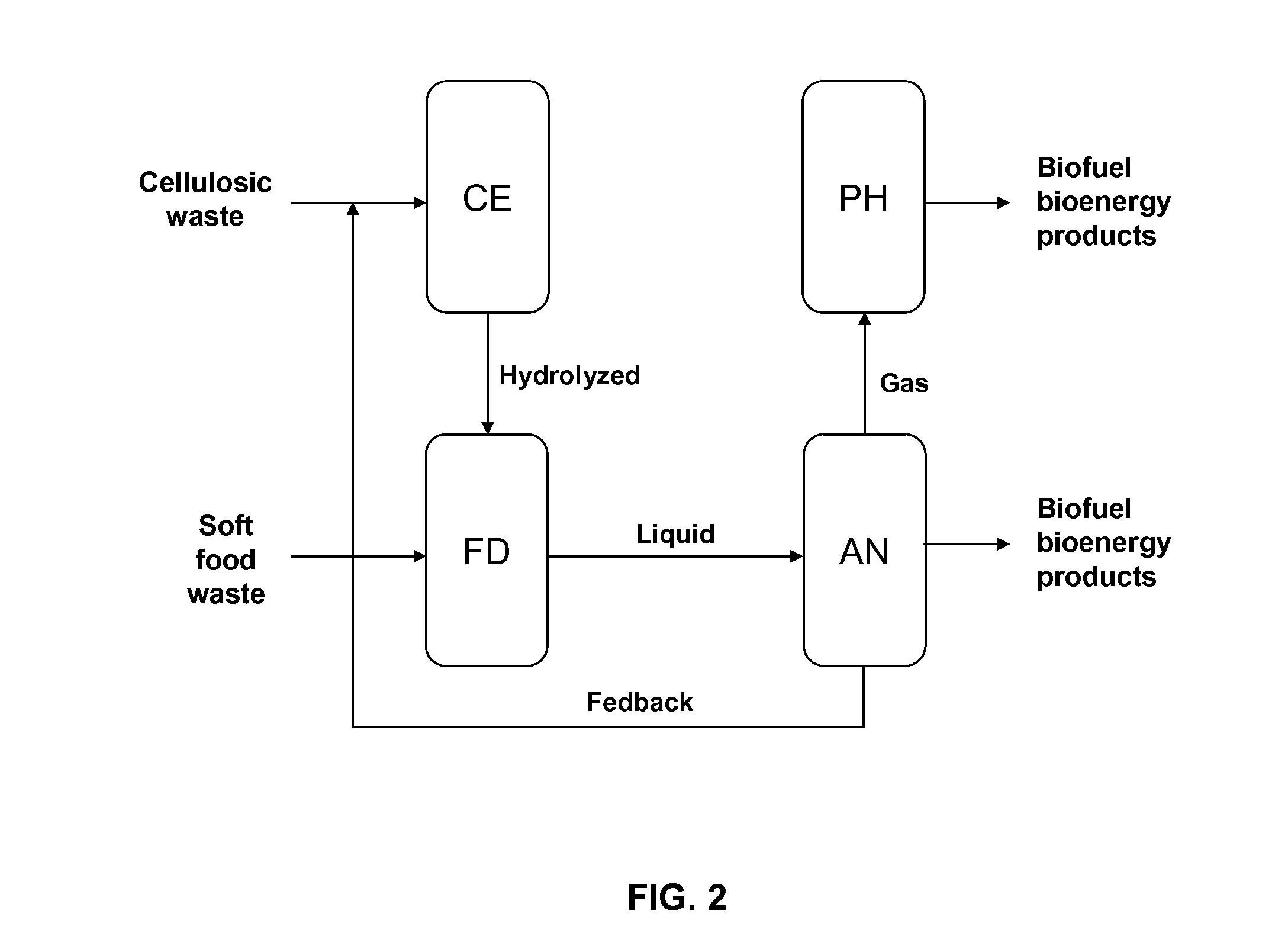Refinery process to produce biofuels and bioenergy products from home and municipal solid waste
a biofuel and solid waste technology, applied in biofuels, waste based fuels, biomass after-treatment, etc., can solve the problems of improper disposal of food waste generated at home or restaurants to waste water or landfill systems, and negative impact on the environment and health of the population
- Summary
- Abstract
- Description
- Claims
- Application Information
AI Technical Summary
Benefits of technology
Problems solved by technology
Method used
Image
Examples
example 1
Testing of a Pre-Treating Physicochemical Reactor for the Hydrolysis of Solid Cellulosic Waste Materials
[0100]This example demonstrates that recalcitrant lignocellulosic materials from home and municipal solid waste can be hydrolyzed in a pre-treat phisicochemical reactor. The MSW contain high amounts of lignocellulosic materials including paper, organic plastics, peels of food vegetables, and yard waste. These cellulosic materials are difficult to process directly in a biosynthetic bioreactor.
[0101]An alternative to physicochemical processes for breakdown (hydrolysis) these cellulosic materials is the acid or alkaline treatment at relative high temperatures. Physicochemical treatment in accordance with the invention has several advantages over other methods including enzymatic methods in terms of its simplicity economy, and high yield of cellulose hydrolysis.
[0102]The activity of acid or alkali compounds are enhanced with mixing and incubation processes at temperatures between 25 t...
example 2
Testing of a Heterogeneous Bioreactor for the Production of Methane from Treated Cellulosic Waste Material
[0105]This example shows that the pre-treated MSW (cellulose hydrolyzed) can be efficiently metabolized to produce methane in a bioreactor. The aim of physicochemical treatment is to improve or allow the anaerobic digestion of the solid waste, where high concentrations of cellulosic materials are present.
[0106]Batch tests were performed in a 1-L UASB anaerobic reactor to assess waste biodegradability and production of methane. The reactor was fed with waste previously treated to hydrolyze the cellulose components. A bacteria consortium of a previous methanogenic bioreactor was used as inoculum. Treated cellulosic waste, non-treated cellulosic waste, soft food waste, and a control sample consisting of ethanol, were digested. The total organic processed for each matter was equivalent to 10 g of chemical oxygen demand (COD) / L in all samples.
[0107]The biogas volume produced was meas...
example 3
Testing of a Heterogeneous Bioreactor System for the Production of Ethanol from Treated Cellulosic Waste Material
[0110]This example demonstrates the production of ethanol from treated (hydrolysis of cellulosic materials) municipal solid waste.
[0111]A 1-L bioreactor containing 500 ml of pre-treated waste (10 g COD / L) was inoculated with a selected culture of the yeast of Saccharomyces sp. A control system containing glucose as carbon source was used to compare with treated and non-treated lignocelluloic samples. The reactor was maintained at room temperature and agitated only by recirculation. Samples were collected and analyzed every 8 hours for 3 days for COD and ethanol concentrations.
[0112]The results show that ethanol reached its maximum production after 48 hours of incubation after which production decreased. As can be observed in FIG. 7, after 48 hours of culture, approximately 0.48, 0.52, and 0.54 ml of ethanol / gram of COD were produced from treated, non-treated, and half-tre...
PUM
 Login to View More
Login to View More Abstract
Description
Claims
Application Information
 Login to View More
Login to View More - R&D
- Intellectual Property
- Life Sciences
- Materials
- Tech Scout
- Unparalleled Data Quality
- Higher Quality Content
- 60% Fewer Hallucinations
Browse by: Latest US Patents, China's latest patents, Technical Efficacy Thesaurus, Application Domain, Technology Topic, Popular Technical Reports.
© 2025 PatSnap. All rights reserved.Legal|Privacy policy|Modern Slavery Act Transparency Statement|Sitemap|About US| Contact US: help@patsnap.com



